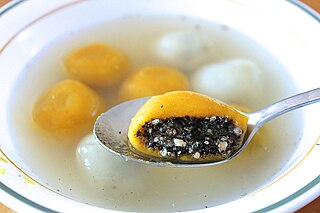
This is a list of varieties of tteok , traditional rice cakes in Korean cuisine.

This is a list of varieties of tteok , traditional rice cakes in Korean cuisine.




Korean cuisine has evolved through centuries of social and political change. Originating from ancient agricultural and nomadic traditions in Korea and southern Manchuria, Korean cuisine reflects a complex interaction of the natural environment and different cultural trends.

Songpyeon is a traditional Korean food made of rice powder. Its shape resembles a half moon and it is a representative rice cake of Korean holidays and traditional culture. It is a type of tteok, small rice cakes, and variety of fillings are used-- some include red bean paste, toasted sesame seeds, and chestnuts. Songpyeon is traditionally eaten during the Korean autumn harvest festival, Chuseok, where it is often prepared by families at home. It is a popular symbol of traditional Korean culture. The earliest records of songpyeon date from the Goryeo period.

Tteok is a class of Korean rice cakes made with steamed flour made of various grains, including glutinous or non-glutinous rice. Steamed flour can also be pounded, shaped, or pan-fried to make tteok. In some cases, tteok is pounded from cooked grains.

A rice cake may be any kind of food item made from rice that has been shaped, condensed, or otherwise combined into a single object. A wide variety of rice cakes exist in many different cultures in which rice is eaten and are particularly prevalent in Korea and Japan. Common variations include cakes made with rice flour, those made from ground rice, and those made from whole grains of rice compressed together or combined with some other binding substance.

Tangyuan are a traditional Chinese dessert made of glutinous rice shaped into balls that are served in a hot broth or syrup. They come in varying sizes, anything between a marble to a ping pong ball, and are sometimes stuffed with filling. Tangyuan are traditionally eaten during the Lantern Festival, but because the name is a homophone for union and symbolizes togetherness and completeness, this dish is also served at weddings, family reunions, Chinese New Year, and the Dōngzhì festival.

Tteokbokki (떡볶이), or simmered rice cake, is a popular Korean food made from small-sized garae-tteok called tteokmyeon or commonly tteokbokki-tteok. Eomuk, boiled eggs, and scallions are some common ingredients paired with tteokbokki in dishes. It can be seasoned with either spicy gochujang or non-spicy ganjang -based sauce; the former is the most common form, while the latter is less common and sometimes called gungjung-tteokbokki.

Hangwa is a general term for traditional Korean confections. With tteok, hangwa forms the sweet food category in Korean cuisine. Common ingredients of hangwa include grain flour, fruits and roots, sweet ingredients such as honey and yeot, and spices such as cinnamon and ginger.

Hwajeon, or flower cake is a small Korean pan-fried rice cake. It is made out of glutinous rice flour, honey and edible petals from seasonal flowers, such as rhododendron. It is eaten during the festivals of Samjinnal and Buddha's Birthday.

Sirutteok (시루떡) is a type of Korean rice cake (tteok) traditionally made by steaming rice or glutinous rice flour in a "siru" (시루).
Korean regional cuisines are characterized by local specialties and distinctive styles within Korean cuisine. The divisions reflected historical boundaries of the provinces where these food and culinary traditions were preserved until modern times.

Danja is a variety of steamed tteok made with glutinous rice flour, sweet fillings, and sweet coatings.

Bukkumi (부꾸미) is a pan-fried tteok made with glutinous rice flour or sorghum flour. It is a flat half-moon shaped cake filled with white adzuki bean paste or mixture of toasted and ground sesame seeds, cinnamon powder, and sugar or honey. The color varies from white to yellow, pink, or dark green. Bukkumi is often coated with honey or syrup, and garnished with shredded chestnuts, jujube, or rock tripe. There is also a variety of bukkumi which is flat and round and does not have any filling.

Injeolmi is a variety of tteok, or Korean rice cake, made by steaming and pounding glutinous rice flour, which is shaped into small pieces and usually covered with steamed powdered dried beans or other ingredients.

Red bean paste or red bean jam, also called adzuki bean paste or anko, is a paste made of red beans, used in East Asian cuisine. The paste is prepared by boiling the beans, then mashing or grinding them. At this stage, the paste can be sweetened or left as it is. The color of the paste is usually dark red, which comes from the husk of the beans. In Korean cuisine, the adzuki beans can also be husked prior to cooking, resulting in a white paste. It is also possible to remove the husk by sieving after cooking, but before sweetening, resulting in a red paste that is smoother and more homogeneous.

Gomul (고물) refers to a number of powdered coatings, toppings, fillings, or dips in Korean cuisine.
{{cite web}}: CS1 maint: archived copy as title (link)